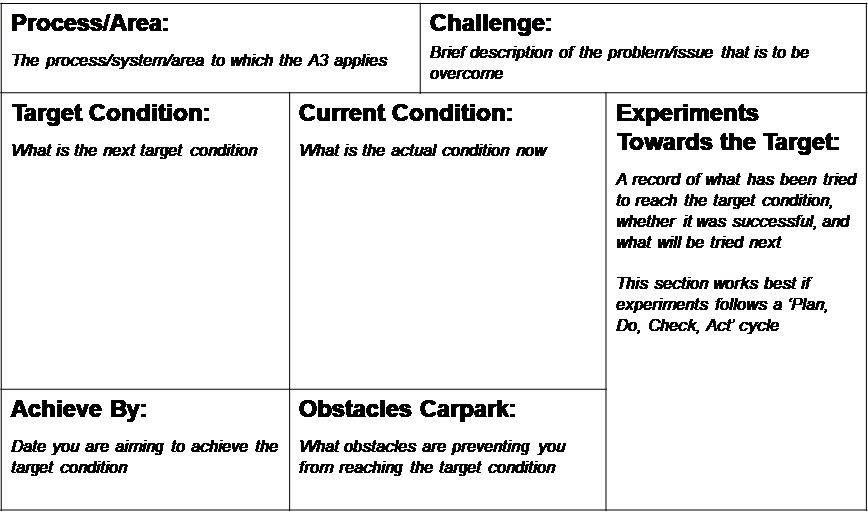
Rising to the Challenge
Visions. Missions. Goals. Objectives. They are great for creating a shared understanding and bringing teams together for a common purpose… until they’re not.
Having a team contribute to the goals and objectives for their project or area can be a great way to communicate the organisations vision and promote team cohesion. Measuring progress against objectives can help maintain momentum and allow the team to see progress, identify issues, and share success.
Sounds great, right? Or alternatively…
Visions and goals are just overly-optimistic business jargon that serve no real purpose. They have no bearing on my work and discussing them is a waste of time when I could be doing something more important. Objectives are just a way for management to shirk their responsibilities, and measuring objectives leads to unnecessary paperwork and micromanagement.
As Business Analysts, it is drilled into us how important a shared vision and/or goal is when coordinating a team of individuals to implement and sustain business change. Cascading visions and objectives can be a great way to align work across an organisation, ensuring the goals and objectives of the component parts contribute to the organisation vision and/or mission as-a-whole. It is accepted practice to set, regularly review and tweak goals and objectives, and there are several techniques to support the discovery, definition, communication and monitoring of goals and objectives, including MOST, SMART, and Balanced Scorecards.
However, for some, it can be hard to see the point of goal and objective setting. There can be a variety of reasons for this, including but not limited to:
- Feeling threatened by the prospect of being managed/measured
- Disappointment with previous efforts to define and deliver on goals and objectives
- Difficulty seeing how the wider vision relates to their day-to-day work
- General resistance to change
In cases where you have several individuals that feel this way, trying to define goals and objectives as a group is likely to prove fruitless.
So how can you bring a team together without a shared goal? Are there other ways to create a clear, shared purpose for a team?
The Challenge.
An alternative to setting a goal is to set a challenge. Having a challenge to overcome can create the clear direction and purpose required to coordinate work across a team.
The difference between a goal and a challenge you ask? Not a lot.
Overcoming a challenge is as good a goal as any. However, while the end-result may be the same, the mindset for getting there can be quite different:
- ‘How can we contribute to the organisation vision?’ vs. ‘What challenges do we face in meeting the demands of the organisation?’
- ‘What is our common purpose?’ vs. ‘What is stopping us from moving forward together?’
- ‘How do we measure progress against the objective?’ vs. ‘What steps have we taken to overcome the challenge?’
In the same way you can analyse and decompose goals to create objectives and requirements, a challenge can be further decomposed into target conditions and steps. Ultimately, challenges can be reworded to create goals, target conditions objectives, and steps requirements – meaning they can still be analysed and aligned to the visions/goals of the wider organisation/department.
Are there techniques that can help?
Yes, there are. More generic techniques such as Brainstorming, Mind Mapping and Affinity Mapping can help with the initial identification of challenges. However, when it comes to decomposing challenges into target conditions and steps, the A3 is a particularly useful technique.
The A3 (so named because they generally cover a single sheet of landscape A3) is a technique that has been developed and used as part of the Toyota Kata and adopted by Lean organisations. It is used to identify, define and manage process improvements. While Toyota uses A3’s as part of a wider process improvement philosophy and cultural mindset, an A3 can be a powerful stand-alone technique for supporting the discovery, definition and documentation of challenges, as well as record any progress in overcoming them.
The main idea behind the A3 can be summarised in four simple steps:
- Understand the Challenge
- Grasp the Current Condition
- Establish the next Target Condition
- Experiment towards the Target Condition
Templates for setting out an A3 vary. I have provided an example below. However, it is important to note that regardless of how sections are laid out on the page, it is important that the four key elements of the A3 are tackled in the order set out above – Challenge, Current Condition, Target Condition, Experiments. It’s also important to realise that the Target Condition should be the next Target Condition – there may be multiple Target Conditions before a Challenge is overcome.

There are a couple of benefits to using the A3 technique:
- Its very logical, so will likely suit people who have a more logical mindset
- It’s can be used as a way of documenting and allocating discrete pieces of work
- It works well for situations where the path from the Current to the Target Condition is unclear, allowing time to think, explore options, and experiment – rather than feeling forced to articulate a solution straight away.
In the end…
Challenges and Target Conditions may be used as an alternative to the traditional approach of setting cascading goals and objectives. Involving team members in the process of discovering and defining challenges can be a good team-building exercise, especially in circumstances where a team feel removed from the vision of the wider organisation. A3’s can be used as a framework for documenting challenges and working towards overcoming them. While not a panacea for dealing with resistors and detractors, it is another tool that may prove useful in any journey the involves coordinating groups of people, aligning goals and objectives, and creating a shared vision to support the successful implementation of business change.
Resources:
Toyota Kata: Managing People for Improvement, Rother, Mike, 2009.
Anna Rajander, February 2021.
ป้ายโฆษณา
… [Trackback]
[…] Information on that Topic: batimes.com/articles/rising-to-the-challenge/ […]